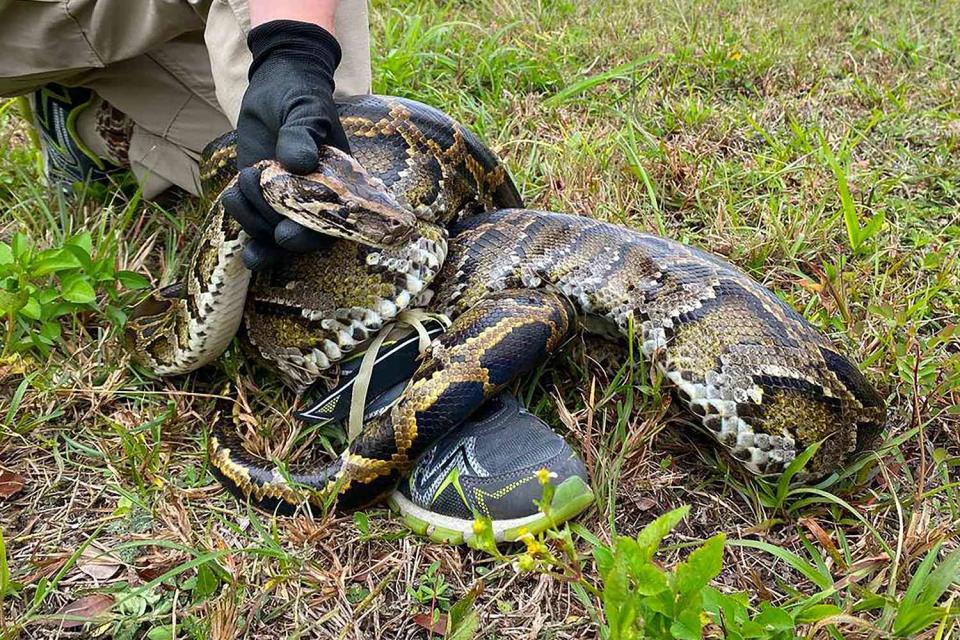'Resilient' Python Invasion in Florida Could Be 'Impossible' to Stop, U.S Officials Say
The U.S. Geological Survey found that the invasive Burmese python population in Florida has expanded from a small area near Everglades National Park to the bottom third of the Sunshine State

A recent paper produced by the U.S. Geological Survey claims the "eradication of pythons in southern Florida is likely impossible" following the invasive species' rapid spread across the state.
According to the South Florida Sun-Sentinel, the authors of the paper analyzed 250 research initiatives from over three decades about the snake species' presence in Florida to write "Burmese pythons in Florida: A synthesis of biology, impacts, and management tools," which was published in January.
The paper found that the first Burmese python sightings in the wild in Florida were recorded in the 1970s around the state's swampy Everglades National Park (ENP). For years, the random python spottings that popped up in the area were written off as "individual escapes or releases" until the 1990s and 2000s, "when confirmation of a reproducing [python] population in ENP prompted their recognition as an established invasive species."
"In the four decades since the first individual was recorded, the python population has grown and spread, consuming native wildlife and altering the food web in the Everglades," the U.S. Geological Survey paper stated.
Maps shared by the South Florida Sun Sentinel show the impressive size of the Burmese python's spread across southern Florida. The red area on the 2000 map shows where there were reported python removals from 1995 to 2000, according to the outlet, and is contained to the southern tip of Everglades National Park. The 2021 map shows how far the Burmese python "invasion front" has traveled in just 20 years. The snakes — native to southeast Asia — now appear as far north as Broward and Palm Beach counties and are reaching toward Fort Meyers and Lake Okeechobee.

"Pythons have severely impacted native species and ecosystems in Florida and represent one of the most intractable invasive-species management issues across the globe. The difficulty stems from a unique combination of inaccessible habitat and the cryptic and resilient nature of pythons that thrive in the subtropical environment of southern Florida, rendering them extremely challenging to detect," the paper summarized its findings, also addressing some of the reasons it is difficult to gain control of the invasive species.
Burmese pythons are nocturnal, elusive reptiles that avoid crowded areas while wreaking havoc on the natural ecosystem with their enormous appetites and expansive diets.
Related:Missing Pet Python Found 'Frozen' Inside U-Haul Truck Recovers and Reunites with its Owner
"Very low individual detection probabilities for Burmese pythons remain the greatest obstacle to developing landscape-scale control programs. Controlling population expansion and minimizing the impact of pythons to natural resources is a pressing concern as billions of dollars have been spent in attempts to restore the Everglades after more than 100 years of extensive wetland alteration," the paper said.
"Although a wide variety of techniques have been employed to catch pythons across southern Florida, many of these tools have not been evaluated rigorously, largely because of difficulty detecting pythons. Although rapid response to reports of individual pythons in new areas is ongoing, there have not been any concerted efforts aimed at suppression or eradication of python populations, even in limited areas," the paper added, before calling for more research into new "cost-effective control methods" in python management in Florida.
Never miss a story — sign up for PEOPLE's free daily newsletter to stay up-to-date on the best of what PEOPLE has to offer, from juicy celebrity news to compelling human interest stories.
The U.S. Geological Survey paper concluded by noting that "eradication of pythons in southern Florida is likely impossible" due to the detection challenges and the number of resources required to take on the task.
"Suppression of the python population, even at local scales, will require strategic coordination of researchers, land managers, funding, public outreach, implementation of several different complementary tools, and rigorous evaluation of these tools."
For more People news, make sure to sign up for our newsletter!
Read the original article on People.

 Yahoo Autos
Yahoo Autos 